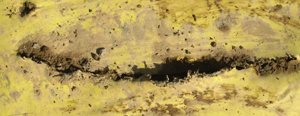 One month after the membrane was placed, the below-grade areas began to leak severely.
One month after the membrane was placed, the below-grade areas began to leak severely.
 The membrane was damaged in multiple areas after the initial placement by construction materials used to complete the structure.
The membrane was damaged in multiple areas after the initial placement by construction materials used to complete the structure.
A below grade transit hub under construction in India initially installed a thick waterproofing membrane to protect the concrete from the saturated soil.
After the initial successful install, construction on the transit hub resumed. Meanwhile, a thin layer of concrete was poured over top of the waterproofing membrane to contain it.
About a month later, some areas began to experience severe leakage. Upon further inspection, it was revealed that machinery and other construction tools had torn and damaged the thick membrane severely. To repair the damage the moisture had caused, the thin layer of concrete had to be removed, and the membrane cut and peeled back. The underlying concrete had to then be jack hammered in order to find the initial entrance point for the water.
This project was significantly delayed by these major repairs, and the costs for the waterproofing more than doubled when including the time spent accessing and repairing the damage.
Incorporating Krystol Internal Membrane (KIM), a hydrophilic crystalline concrete waterproofing admixture, directly into the concrete itself before the initial pour could have saved this project substantial time and money. Classified as a PRAH (Permeability Reducing Admixture – Hydrostatic conditions), KIM is excellent for below grade areas where hydrostatic pressure poses a serious risk to the integrity of the structure. It also protects the concrete permanently, and self-seals hairline cracks, which occur in concrete naturally during the settling process.
 Left: How the concrete should look under the membrane.
Left: How the concrete should look under the membrane.
Right: The concrete under the damaged membrane was completely saturated.
 Top: The workers had to stop the flooding, and tediously remove the concrete layer covering the membrane.
Top: The workers had to stop the flooding, and tediously remove the concrete layer covering the membrane.
Below: The concrete beneath the membrane is badly damaged.






